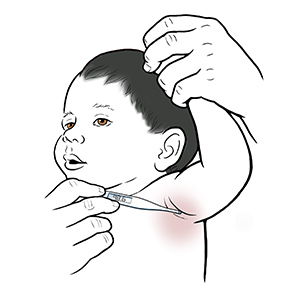Discharge Instructions: Taking an Axillary Temperature (Child)
You take an axillary (armpit) temperature by holding the thermometer under your child’s arm for 4 to 5 minutes. Do this with care to get a correct reading. Note that taking a child’s temperature under the arm is less accurate than taking the temperature in the rectum. That's especially the case for babies younger than 3 months old.
Get the thermometer ready
-
Use a digital thermometer that is made only for underarm use. Don't use a mercury thermometer.
-
Take the cover off.
-
Clean the thermometer before each use.
-
Be sure the thermometer is at room temperature when you use it.
Position your child
-
Gently lift your child’s arm.
-
Place the tip of the thermometer in the fold of the child’s armpit. To get a true reading, the thermometer must rest directly against the child’s skin on all sides.
-
Lower the arm back down to your child’s side.

Take the temperature
-
Follow the instructions for using your thermometer.
-
Keep your child’s arm against their side for 4 to 5 minutes. This keeps the thermometer in place and gives an accurate reading.
-
When the thermometer beeps, remove it and read the temperature on the display.
-
Normal axillary temperature is about 97.6°F (36.4°C) to 99.4°F (37.4°C). An axillary temperature is often 1 degree lower than oral or rectal temperatures. So it can help you gauge whether your child may have a fever. But it's not the most reliable at any age. Your healthcare provider may advise confirming a fever with a rectal, forehead, ear, or mouth temperature.
-
Before putting the thermometer away, clean it with soap and warm water. And put the cover back on.


Follow-up
Make a follow-up appointment as directed by our staff.
Fever and children
Use a digital thermometer to check your child’s temperature. Don’t use a mercury thermometer. There are different kinds and uses of digital thermometers. They include:
-
Rectal. For children younger than 3 years, a rectal temperature is the most accurate.
-
Forehead (temporal). This works for children age 3 months and older. If a child under 3 months old has signs of illness, this can be used for a first pass. The provider may want to confirm with a rectal temperature.
-
Ear (tympanic). Ear temperatures are accurate after 6 months of age, but not before.
-
Armpit (axillary). This is the least reliable but may be used for a first pass to check a child of any age with signs of illness. The provider may want to confirm with a rectal temperature.
-
Mouth (oral). Don’t use a thermometer in your child’s mouth until they are at least 4 years old.
Use a rectal thermometer with care. Follow the product maker’s directions for correct use. Insert it gently. Label it and make sure it’s not used in the mouth. It may pass on germs from the stool. If you don’t feel OK using a rectal thermometer, ask the healthcare provider what type to use instead. When you talk with any healthcare provider about your child’s fever, tell them which type you used.
Below is when to call the healthcare provider if your child has a fever. Your child’s healthcare provider may give you different numbers. Follow their instructions.
When to call a healthcare provider about your child’s fever
For a baby under 3 months old:
-
First, ask your child’s healthcare provider how you should take the temperature.
-
Rectal or forehead: 100.4°F (38°C) or higher
-
Armpit: 99°F (37.2°C) or higher
-
A fever of ___________as advised by the provider
For a child age 3 months to 36 months (3 years):
-
Rectal or forehead: 102°F (38.9°C) or higher
-
Ear (only for use over age 6 months): 102°F (38.9°C) or higher
-
A fever of ___________ as advised by the provider
In these cases:
-
Armpit temperature of 103°F (39.4°C) or higher in a child of any age
-
Temperature of 104°F (40°C) or higher in a child of any age
-
A fever of ___________ as advised by the provider
Online Medical Reviewer:
Donna Freeborn PhD CNM FNP
Online Medical Reviewer:
Liora C Adler MD
Online Medical Reviewer:
Stacey Wojcik MBA BSN RN
Date Last Reviewed:
12/1/2022
© 2000-2024 The StayWell Company, LLC. All rights reserved. This information is not intended as a substitute for professional medical care. Always follow your healthcare professional's instructions.